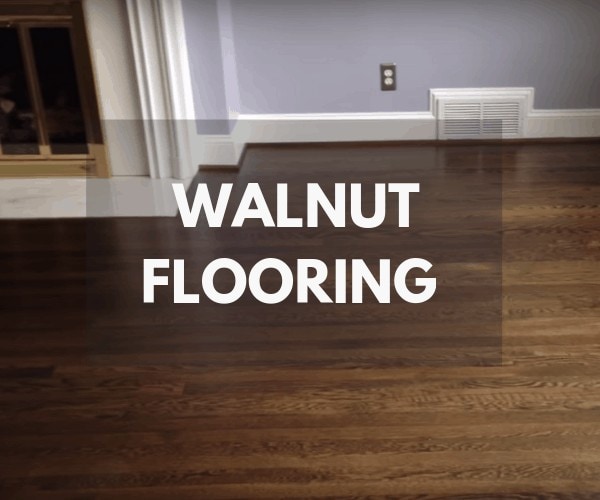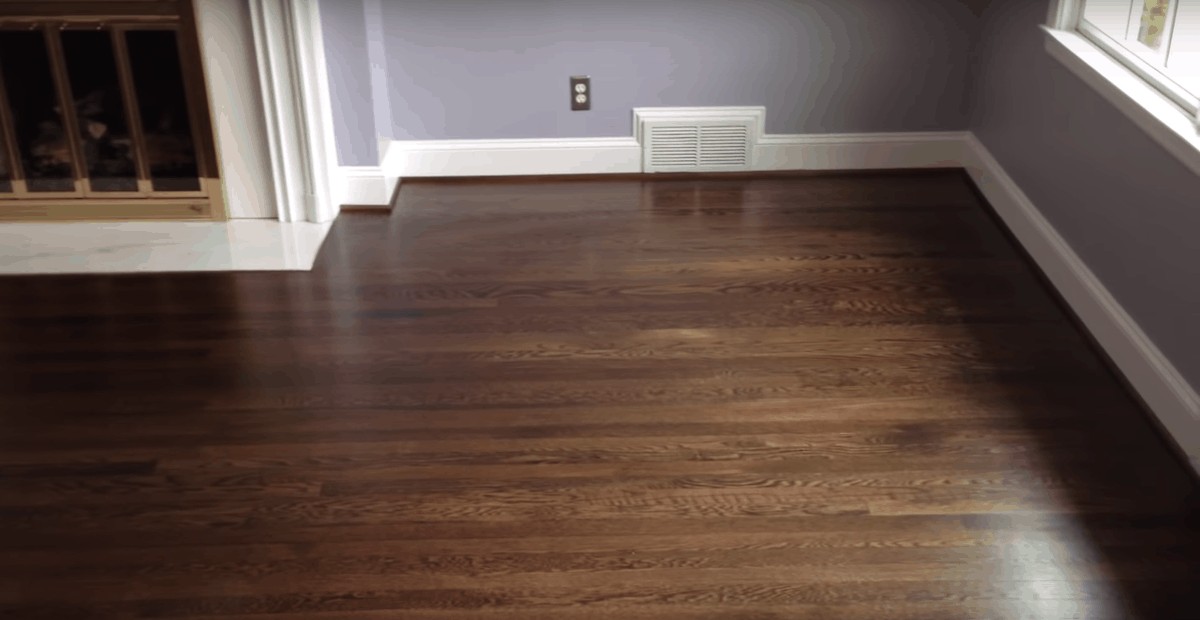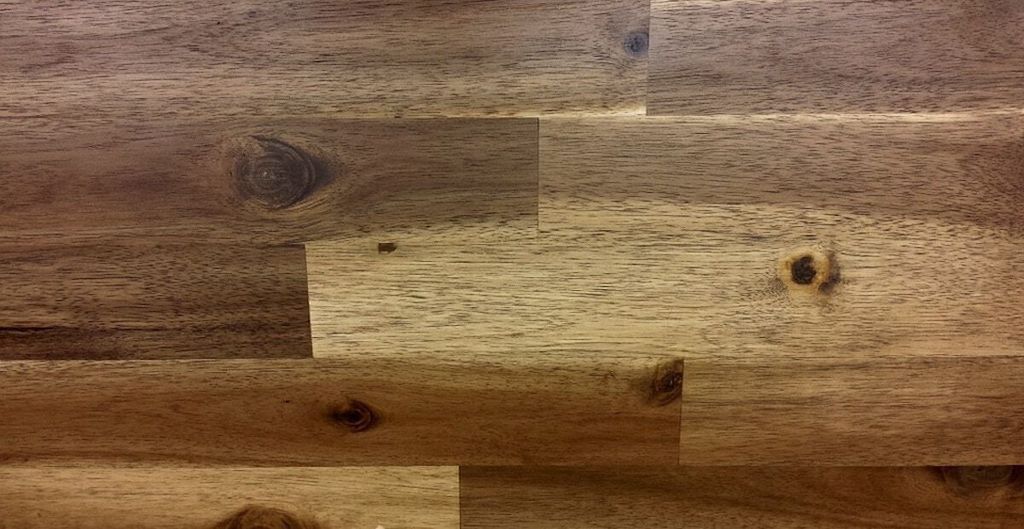Walnut is one of the most beautiful and popular choices when it comes to home decor. It’s deep, rich color lends warmth to your home that few other kinds of wood can, and it’s characteristics make it ideal for use anywhere in the home, including your floors.
Today, we’ll cover everything you need to know about walnut wood and walnut flooring, so you can decide if it’s the best choice for your new flooring installation.
Types of Walnut Used in Flooring
When it comes to walnut, two main types are used for flooring, as well as other applications throughout the home.
North American Walnut
The most popular type of walnut for flooring is North American walnut, which is sometimes called black walnut, or gunwood.
This species grows throughout the eastern and central United States, although the vast majority of walnut for flooring comes from the middle of the country. North American walnut is among the most sustainable tree species, as it’s regularly replanted by those who harvest it, and seeds that fall from other walnut trees often sprout into new saplings.
One especially interesting characteristic of this species is the wide variation in color it possesses. North American walnut can range from a light cream color to a rich chocolate brown, depending on where it’s harvested from. The sapwood of the tree is typically very light in color, while it’s heartwood is significantly darker.
For flooring purposes, the sapwood is often steamed to lend it a bit more color and depth. In its natural state, it’s exceptionally light in color.
This species of walnut is known for its wide variations in the grain. While most walnut features a straight grain, it’s easy to find walnut with a pronounced curly grain, which is more desirable for virtually any application. As a result, you can expect to spend significantly more on the flooring if it features a unique grain.
Beyond flooring, North American walnut is a popular wood for cabinets and furnishings, gun stocks, and even musical instruments.
Brazilian Walnut
Hailing from Brazil and the Lesser Antilles, Brazilian walnut is among the most beautiful and exotic woods available for flooring. It’s well known for its exceptional hardness, with a score of 3,684 lbf on the Janka hardness scale. The hardness of wood doesn’t mean it’s impervious to damage. A higher rating typically denotes a more durable floor.
Brazilian walnut is known for its incredibly rich and deep color. Typically, the color ranges from a medium brown to a deep, almost black brown. This color may feature sharp contrast from its yellowish sapwood depending on the grade of walnut you select.
That brings us to our next point: Brazilian walnut has a grading system. The grading system determines it’s visual qualities and price.
- Clear grade – This grade closely resembles North American walnut. It features a uniform color that’s medium to dark brown. Only the heartwood is used in this type of grade.
- Select grade – Select grade makes use of both the sapwood and the heartwood to create a beautiful and varied appearance. The majority of the wood is dark, with sharp contrast provided by the lighter sapwood.
- Rustic grade – Rustic grade features the widest variations in color and grain consistency. It’s typically the most expensive type of walnut available.
- Lapacho grade – This interesting grade sorts out all of the walnut with a deep green color.
Keep in mind that whenever you’re dealing with exotic hardwoods, they’re susceptible to UV damage. It’s important you take some precautions to keep them looking their best. Make sure that you have window treatments in place in the rooms that feature exotic flooring. You should also consider applying a UV film over windows to prevent sun damage.
It’s also a good idea to rotate rugs and furniture regularly to ensure that the wood ages uniformly.
The Benefits of Using Walnut Flooring
When it comes to choosing flooring, there’s inherent pros and cons associated with each species of wood. Walnut possesses many characteristics which lend itself to use as a flooring material, which is why it’s soared in popularity.
For one, North American walnut is affordable compared to other woods, like red oak. It’s not quite as hard as oak, and it measures 1,010 lbf on the Janka scale. While this is a bit soft for a hardwood, walnut is still hard enough to stand up to years of use and abuse.
Both varieties of walnut are also easy to work with. North American walnut grips nails well, and it’s also easy to glue. This provides installers with a variety of options for securing the flooring. Once installed, it’s easy to accentuate the beautiful, rich grain of the wood with the stain of your choice.
In the case of Brazilian walnut, it’s exceptional hardness makes it one of the most durable options available for flooring.
From an environmental perspective, people consider North American walnut a green choice. The U.S. Department of Agriculture monitors the harvesting of the species. They take many steps to ensure that the wood is harvested in a way that doesn’t impact the environment.
Walnut and other flooring materials are also an excellent choice for families who deal with allergies. Hardwood is a much more hypoallergenic choice compared to carpet or rugs.
Drawbacks of Using Walnut
The benefits of using walnut often outway the flaws with this flooring. However, there are a few things you’ll want to be aware of before making your selection.
For one, North American walnut is rarely the best choice for families that have pets. Since this species is a bit on the softer side, it’s more susceptible to scratches. Pets are a significant contributor to scratched flooring.
For those who are dead set on using walnut, this issue is usually avoidable by using a hard finish or clear coat over the floor. They protect the wood beneath.
With Brazilian walnut, it’s incredible hardness makes it susceptible to splitting when it’s nailed. This means all nails should be driven into pilot holes. This adds time and money to the install process.
Engineered vs. Solid Hardwood
As you search for the flooring of your dreams, you’re sure to encounter two different types of flooring: engineered flooring and solid hardwood.
Depending on the type of installation you’re dealing with, you’ll find that one type is a better choice for you than the other. If you’re installing your flooring above grade or at grade, either type of flooring will make an excellent choice for you.
Meanwhile, if you’re installing the flooring below grade, such as in a basement, you’ll want to avoid using solid hardwood.
As the ambient humidity of a room changes, the wood will expand or contract based on those conditions. Rooms that are particularly humid, like basements, can ruin your beautiful flooring, as the expansion and contraction of the wood often cause warping, cracking, or splitting, that will destroy the look and integrity of your flooring.
To combat this issue, the flooring industry has developed engineered hardwood flooring. Engineered flooring is made from several different layers of wood, and the base layers may be an entirely different species from the top layer, which is what you and your guests will see when they walk into the room.
With engineered flooring, the grain of each layer is opposite the grain of the layer before it, which helps to combat the effects of expansion and contraction, so that even if you’re installing flooring in a humid room, or a room that has wide variances in humidity, you’ll avoid the pitfalls that are inherent with wood.
How to Care for Hardwood Flooring
Whether you choose North American walnut, Brazilian walnut, engineered, or hardwood, it’s essential that you take care of your new flooring to keep it as beautiful and vibrant as the day it was installed. These tips will help ensure your floors stay beautiful and last forever, regardless of the wood species you choose.
- Regularly sweep your floors to remove dust and debris, which act as abrasives which can stretch your floors finish.
- Invest in a vacuum that doesn’t have a beater bar, and vacuum your floors regularly to remove dust and debris that’s trapped between boards.
- Add area rugs designed for hardwood floors in high traffic areas of the home. Add mats by each entryway to help trap dirt and debris to prevent it from being tracked onto your floors.
- Mop your floor weekly with a damp mop. Never use a wet mop to clean your hardwood floors.
Final Word
Hardwood flooring is one of the best ways to add natural beauty and warmth to your home. There are plenty of viable species you can use for your next flooring project, and walnut is among the most popular and beautiful options available.
North American walnut offers a beautiful grain, and it’s affordable enough to warrant consideration for your next flooring project. Brazilian walnut can add exotic beauty to your home, and it’s arguably the most durable wood in the world, making it an ideal choice for flooring.
Whether you choose North American or Brazilian, a walnut floor is a great way to unlock the beauty of your home and elevate your design to the next level.
Once your new floor is installed, check out our stunning walnut DIY kits, like this live edge walnut coffee table or walnut floating shelf, and add even more beautiful wood to your home!



